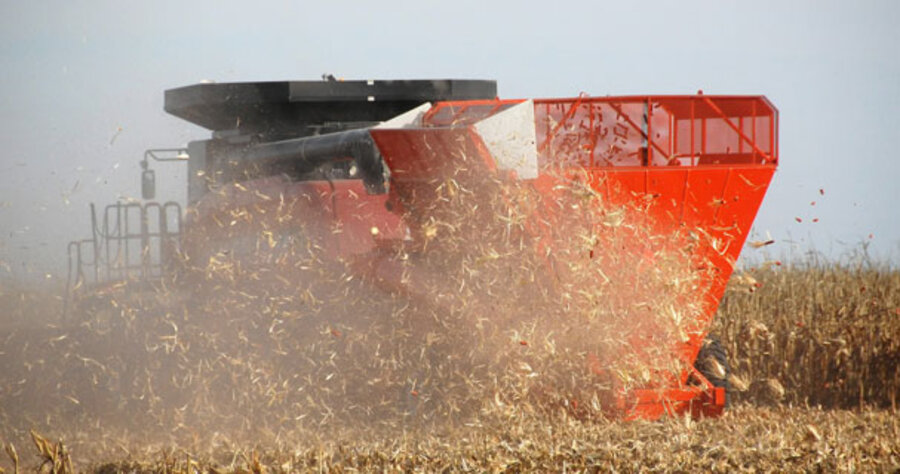US eyes shift from corn ethanol
Loading...
| Chicago
America’s love affair with corn-based ethanol is cooling – at least in Washington.
Some legislators blame the rising use of corn as a biofuel as a key factor behind high food prices. Others want to freeze the federal mandate on biofuels production at current levels, reversing legislation passed just a few months ago that increases it through 2022. Still others are pushing to shift tax incentives away from corn-based to cellulose-based ethanol in the nearly completed farm bill.
These moves represent a dramatic backlash against corn ethanol, which until a few months ago was widely viewed as a boon for both farmers and consumers. Many experts worry that Washington’s new skepticism will undo important progress the US has made in replacing foreign oil with domestic energy alternatives. But others say that done right, a shift toward cellulose – nonfood plant material like grasses and crop residues – could reduce US reliance on imported oil just as well as corn does. And it would accomplish it with fewer food and environmental trade-offs.
“I think there could be some really productive results from all this hand-wringing,” says Nathanael Greene, a senior policy analyst at the Natural Resources Defense Council, a New York-based environmental group. The key is to encourage experimentation with biofuels to see which one can deliver the most value with the least environmental side effects, he adds. “Tax credits [for cellulose] have the right intention, but they’re focused on trying to pick the winner instead of picking the best performance.”
At this point, corn ethanol is the runaway winner among biofuels. The US produced almost 6.5 billion gallons of ethanol last year, representing less than 5 percent of US gasoline supplies. Cellulosic ethanol, by contrast, has not even been commercialized.
It has big backers. “The solution to the issue of corn-fed ethanol is cellulosic ethanol,” President Bush told reporters Tuesday.
But no large-scale, cost-effective cellulosic ethanol operations exist. Research is under way and many scientists expect it to be available in commercial form within the next several years.
That option can’t come soon enough for those who blame biofuels for high food prices.
Last week, Texas Gov. Rick Perry (R) asked the federal government to halve the amount of ethanol that his state is supposed to use under the Renewable Fuel Standard, or RFS. “This misguided mandate is significantly affecting Texans’ family food bill,” he said in a statement.
Texas Sen. Kay Bailey Hutchison (R) introduced legislation freezing the RFS mandate at current levels. “This is a common-sense measure that will reduce pressure on global food prices and restore balance to America’s energy policy,” she wrote in an op-ed this week.
Many experts say that ethanol is an easy scapegoat for a complex problem. The price of corn, they point out, is often only a tiny percentage of the final food product, and many other commodities are also rising in price right now. High energy costs, rising protein demand, labor costs, and market forces have all played a role.
“We’re not downplaying the fact that there are folks having a tough time buying groceries, but to scare those folks to death [by saying it’s] because we’re making ethanol is an injustice,” says Jon Doggett, vice president of public policy for the National Corn Growers Association in Washington. Just a couple years ago, he notes, he was taking calls from people angry that the low price of corn was feeding America’s obesity. “Now they’re accusing us of intentionally starving people to death around the world.”
Legislators are giving a nod to the ethanol issue in the tax package that is reportedly a part of the farm bill. It would cut the current 51-cent a gallon ethanol tax credit by 4 to 6 cents and would create a $1.01 a gallon tax credit for cellulosic ethanol.
It’s a signal of shifting support from key lawmakers, though critics note that the effect will largely be symbolic, especially since commercial-scale cellulosic ethanol doesn’t yet exist.
“They’re shifting the credit, but the [ethanol] mandate is still there,” says Sandra Schubert, director of government affairs for the Environmental Working Group, a Washington-based environmental group that opposed the rising ethanol-production mandate under RFS. “It doesn’t do anything to prevent the food crisis and the environmental and natural-resource effects we’re seeing.”
In the end, the market may dictate the demand for ethanol production. “Up to 14 billion gallons, corn ethanol is going to grow,” predicts Bruce Babcock, director of the Center for Agricultural and Rural Development at Iowa State University in Ames. “Somewhere around there, it will stop because ... the trade-offs will get too severe.” Eventually, he adds, cellulosic ethanol will become a major player, and will likely complement the corn-fed production. “But it won’t happen overnight, and it won’t be on a schedule that Congress dictates.”





